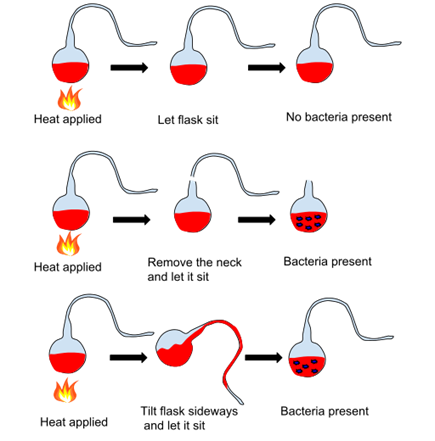
PUMPA - SMART LEARNING
எங்கள் ஆசிரியர்களுடன் 1-ஆன்-1 ஆலோசனை நேரத்தைப் பெறுங்கள். டாப்பர் ஆவதற்கு நாங்கள் பயிற்சி அளிப்போம்
Book Free DemoThe theory of spontaneous generation, often known as abiogenesis, states that life formed spontaneously from abiotic, dead substances.
The various observations supporting this theory are as follows:
The various observations supporting this theory are as follows:
- Fishes originated from mud.
- Fly larvae developed from rotten meat.
- Frogs developed from moist soil.
- Insects developed from decaying matter.
This theory was criticized by Lazzaro Spallanzani, Francisco Redi and Louis Pasteur by their experiments which concluded that life originated from pre-existing life and named the theory biogenesis.
Redi’s experiment:
In 1668 an Italian physician Francesco Redi proved that life spontaneously originated from pre-existing life by the following experiment.
- Redi took cooked meat so that no living organisms are alive in it.
- He placed the meat in three different jars.
- He left one of the jars uncovered, one sealed with a cork and the other with gauze.

A picture illustrating Redi's experiment
- The decaying meat in the jar attracted flies.
- In the uncovered jar, flies entered and layed eggs which eventually the new larvae has developed.
- In the jar covered with cork and gauze, flies were unable to enter the jar. Hence, no larvae were found.
- But larvae were found on the gauze as the flies laid eggs on them.
Hence, through this experiment, Redi proved that life spontaneously originated from pre-existing life (flies) rather than non-living material (cooked meat).
A video explaining Redi's experiment
Pastuer's experiment:
- In this experiment, Louis Pasteur took broths (killed yeast) in a long-necked flask, and then he bent the neck of the flask (swan neck flask).

A picture illustrating Pastuer's experiment
- He boiled the broth in the flask so that the microorganisms in this flask are killed.
- The curved neck of the flasks acted as a filter.
- When these flasks were kept months together, no life appeared in them as the neck of the flask trapped the dust particles.
- When this neck was broken off, the broths developed colonies of microbes such as bacteria and moulds.
- Hence, through this experiment, he concluded that the flasks kept airtight with dead yeast did not produce any life forms. However, another flask that was kept open to the air produced living organisms from the deceased yeast.
Reference:
https://commons.wikimedia.org/wiki/File:OSC_Microbio_03_01_Rediexpt.jpg
https://commons.wikimedia.org/wiki/File:Louis_Pasteur_Experiment.svg